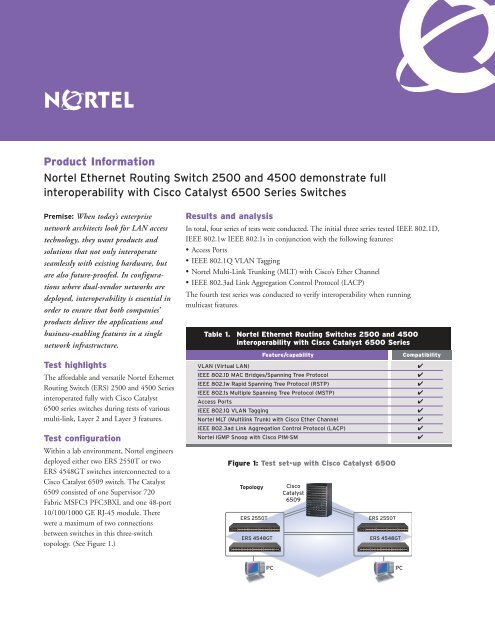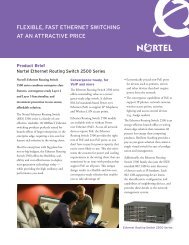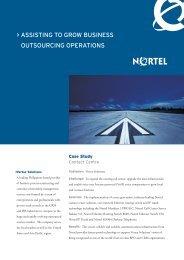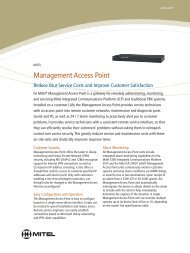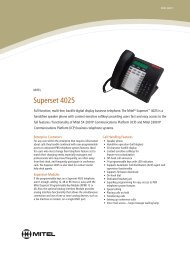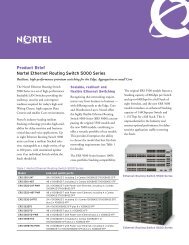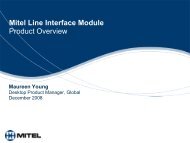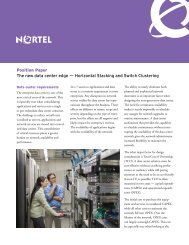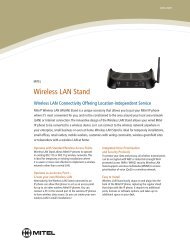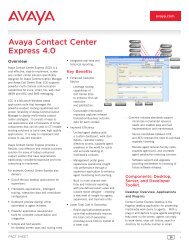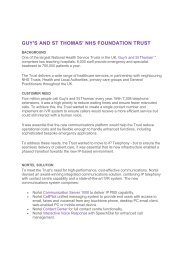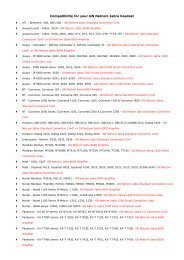Nortel Ethernet Routing Switch 2500 and 4500 ... - Ash Telecom
Nortel Ethernet Routing Switch 2500 and 4500 ... - Ash Telecom
Nortel Ethernet Routing Switch 2500 and 4500 ... - Ash Telecom
Create successful ePaper yourself
Turn your PDF publications into a flip-book with our unique Google optimized e-Paper software.
Product Information<br />
<strong>Nortel</strong> <strong>Ethernet</strong> <strong>Routing</strong> <strong>Switch</strong> <strong>2500</strong> <strong>and</strong> <strong>4500</strong> demonstrate full<br />
interoperability with Cisco Catalyst 6500 Series <strong>Switch</strong>es<br />
Premise: When today’s enterprise<br />
network architects look for LAN access<br />
technology, they want products <strong>and</strong><br />
solutions that not only interoperate<br />
seamlessly with existing hardware, but<br />
are also future-proofed. In configurations<br />
where dual-vendor networks are<br />
deployed, interoperability is essential in<br />
order to ensure that both companies’<br />
products deliver the applications <strong>and</strong><br />
business-enabling features in a single<br />
network infrastructure.<br />
Test highlights<br />
The affordable <strong>and</strong> versatile <strong>Nortel</strong> <strong>Ethernet</strong><br />
<strong>Routing</strong> <strong>Switch</strong> (ERS) <strong>2500</strong> <strong>and</strong> <strong>4500</strong> Series<br />
interoperated fully with Cisco Catalyst<br />
6500 series switches during tests of various<br />
multi-link, Layer 2 <strong>and</strong> Layer 3 features.<br />
Test configuration<br />
Within a lab environment, <strong>Nortel</strong> engineers<br />
deployed either two ERS 2550T or two<br />
ERS 4548GT switches interconnected to a<br />
Cisco Catalyst 6509 switch. The Catalyst<br />
6509 consisted of one Supervisor 720<br />
Fabric MSFC3 PFC3BXL <strong>and</strong> one 48-port<br />
10/100/1000 GE RJ-45 module. There<br />
were a maximum of two connections<br />
between switches in this three-switch<br />
topology. (See Figure 1.)<br />
Results <strong>and</strong> analysis<br />
In total, four series of tests were conducted. The initial three series tested IEEE 802.1D,<br />
IEEE 802.1w IEEE 802.1s in conjunction with the following features:<br />
• Access Ports<br />
• IEEE 802.1Q VLAN Tagging<br />
• <strong>Nortel</strong> Multi-Link Trunking (MLT) with Cisco’s Ether Channel<br />
• IEEE 802.3ad Link Aggregation Control Protocol (LACP)<br />
The fourth test series was conducted to verify interoperability when running<br />
multicast features.<br />
Table 1. <strong>Nortel</strong> <strong>Ethernet</strong> <strong>Routing</strong> <strong>Switch</strong>es <strong>2500</strong> <strong>and</strong> <strong>4500</strong><br />
interoperability with Cisco Catalyst 6500 Series<br />
VLAN (Virtual LAN)<br />
IEEE 802.1D MAC Bridges/Spanning Tree Protocol<br />
IEEE 802.1w Rapid Spanning Tree Protocol (RSTP)<br />
IEEE 802.1s Multiple Spanning Tree Protocol (MSTP)<br />
Access Ports<br />
IEEE 802.1Q VLAN Tagging<br />
<strong>Nortel</strong> MLT (Multilink Trunk) with Cisco Ether Channel<br />
IEEE 802.3ad Link Aggregation Control Protocol (LACP)<br />
Figure 1: Test set-up with Cisco Catalyst 6500<br />
Topology<br />
ERS 2550T<br />
ERS 4548GT<br />
Feature/capability<br />
<strong>Nortel</strong> IGMP Snoop with Cisco PIM-SM<br />
Cisco<br />
Catalyst<br />
6509<br />
ERS 2550T<br />
ERS 4548GT<br />
Compatibility<br />
✔<br />
✔<br />
✔<br />
✔<br />
✔<br />
✔<br />
✔<br />
✔<br />
✔<br />
PC<br />
PC
Series 1<br />
IEEE 802.1D MAC Bridges/Spanning<br />
Tree Protocol Test IEEE 802.1w 1<br />
Engineers ran tests to validate interoperability<br />
between <strong>Nortel</strong> <strong>Ethernet</strong> <strong>Routing</strong> <strong>Switch</strong>es<br />
<strong>2500</strong> <strong>and</strong> <strong>4500</strong> <strong>and</strong> Cisco Catalyst 6500<br />
series. 2 After interconnecting the switches via<br />
st<strong>and</strong>ard <strong>Ethernet</strong> links, engineers verified<br />
that Spanning Tree converged successfully.<br />
Tests also verified that where there was potential<br />
network loop, the spanning protocol was<br />
able to break the loop in the network. When<br />
traffic was sent from one PC to the other, tests<br />
showed that all switches went through the<br />
proper MAC learning process <strong>and</strong> that traffic<br />
was being forwarded between these two hosts.<br />
To demonstrate tagging interoperability<br />
between the switches, engineers ran the same<br />
test case using tagged links (IEEE 802.1Q).<br />
Engineers repeated the same test case when<br />
these switch-to-switch connections were<br />
configured with MLT on the <strong>Nortel</strong> side <strong>and</strong><br />
Ether Channel on the Cisco side. Finally,<br />
LACP (IEEE 802.3ad) was configured between<br />
<strong>Nortel</strong> <strong>and</strong> Cisco switches <strong>and</strong> engineers<br />
verified that switches went through the proper<br />
MAC learning process <strong>and</strong> traffic traversed<br />
between two hosts.<br />
Series 2<br />
IEEE 802.1w Rapid Spanning<br />
Tree Protocol (RSTP) 3<br />
To test RSTP (IEEE 802.1w), engineers<br />
modified the test setup in Section 1 to run<br />
RSTP (IEEE 802.1w) rather than regular<br />
Spanning Tree (IEEE 802.1D) in all switches.<br />
Test cases <strong>and</strong> results are shown in Table 2.<br />
Test cases were repeated to test <strong>Nortel</strong> MLT<br />
with Cisco Ether Channel <strong>and</strong> IEEE 802.3ad<br />
Link Aggregation Control Protocol (LACP).<br />
Results proved that, in the case of all three<br />
Table 2. IEEE 802.1w Rapid Spanning Tree Protocol (RSTP)<br />
Default VLAN with default Spanning Tree group when<br />
Passed<br />
inter-switch links are configured with access ports<br />
Default VLAN with default Spanning Tree group when<br />
Passed<br />
inter-switch links are tagged, IEEE 802.1Q<br />
Non default VLAN with non default Spanning Tree group when<br />
Passed<br />
inter-switch links are configured with access ports<br />
Non default VLAN with non default Spanning Tree group when Failed 3<br />
inter-switch links are tagged 802.1Q<br />
switches, Spanning Tree convergence was<br />
successful <strong>and</strong> that all switches underwent the<br />
proper learning process except the last test case<br />
in Table 2. Tests also showed that both hosts<br />
sent <strong>and</strong> received traffic from each other.<br />
Series 3<br />
IEEE 802.1s Multiple Spanning Tree<br />
Protocol (MSTP)<br />
To test MSTP (IEEE 802.1s), engineers used<br />
the same setup as Section 1 with one modification<br />
— a VLAN default was used in all three<br />
switches. MSTP was enabled <strong>and</strong> a single<br />
region was created in all switches. This test<br />
was run in five different permutations:<br />
• A single access link between switch to<br />
switch connection<br />
• A single tagged (IEEE 802.1Q) link<br />
between switch to switch connection<br />
• MLT on <strong>Nortel</strong> side <strong>and</strong> Ether Channel<br />
on Cisco side when links are access<br />
• MLT on <strong>Nortel</strong> side <strong>and</strong> Ether Channel<br />
on Cisco side when links are tagged<br />
(IEEE 802.1Q)<br />
• LACP (IEEE 802.3ad)<br />
Once again, Spanning Tree convergence was<br />
successful <strong>and</strong> all switches underwent the<br />
proper learning process. As with the other<br />
tests, results verified that both hosts sent<br />
<strong>and</strong> received traffic from one another.<br />
1 <strong>Nortel</strong> <strong>Ethernet</strong> <strong>Routing</strong> <strong>Switch</strong>es support multiple VLANs in a single Spanning Tree group. However, Cisco supports<br />
PVST (per VLAN Spanning Tree group); thus, the default VLAN 1 already belongs to Spanning Tree Group 1.<br />
Engineers ran all these test cases using default VLAN <strong>and</strong> Spanning Tree Group in both vendor switches.<br />
2 By default in both <strong>Nortel</strong> <strong>and</strong> Cisco switches all ports belong to VLAN 1 <strong>and</strong> Spanning Tree group 1.<br />
3 According to IEEE 802.1w implementation, while running this feature, the switch can have only one Spanning Tree<br />
Group. Cisco switch implementation is not compliant with IEEE. Since Cisco switches run RSTP with PVST, on<br />
tagged links all the ports always stay in forwarding mode <strong>and</strong> therefore fail the last test case mentioned in this section.<br />
(See Table 2.)<br />
Test<br />
Results<br />
Series 4<br />
Multicast features<br />
In simple two-switch setups, one ERS <strong>2500</strong><br />
or one ERS <strong>4500</strong> was connected to a Cisco<br />
Catalyst 6500 series switch. Protocol<br />
Independent Multicast-Sparse Mode (PIM-<br />
SM) was configured in the Cisco switch <strong>and</strong><br />
engineers configured Internet Group Management<br />
Protocol (IGMP) snooping in the <strong>Nortel</strong><br />
switch. A multicast server was connected to<br />
the Cisco switch <strong>and</strong> a multicast client<br />
connected to the <strong>Nortel</strong> switch.<br />
In the first part of testing, engineers verified<br />
that the <strong>Nortel</strong> switch recognized Cisco<br />
Catalyst 6500 as an IGMP querier. When<br />
an IGMP join was sent from the client, tests<br />
validated that both <strong>Nortel</strong> <strong>and</strong> Cisco switches<br />
accepted this IGMP join/report. Finally,<br />
testing demonstrated that when the multicast<br />
server started to send multicast data packets,<br />
these packets were forwarded from the Cisco<br />
to the <strong>Nortel</strong> switch <strong>and</strong> then successfully to<br />
the multicast client host.<br />
<strong>Ethernet</strong> <strong>Routing</strong> <strong>Switch</strong><br />
portfolio<br />
The <strong>Nortel</strong> <strong>Ethernet</strong> <strong>Routing</strong> <strong>Switch</strong> portfolio<br />
includes a broad collection of <strong>Ethernet</strong><br />
switching products designed to securely<br />
deliver Layer 2 <strong>and</strong> Layer 3 connectivity for<br />
converged networking. <strong>Nortel</strong>'s VoIP <strong>and</strong><br />
WLAN portfolios are enabled over modular<br />
<strong>and</strong> stackable Power over <strong>Ethernet</strong> (IEEE<br />
802.3af) switches in a variety of densities.<br />
The portfolio offers 10/100 <strong>and</strong> 10/100/1000<br />
interfaces for a wide range of customer<br />
budgets <strong>and</strong> performance requirements.<br />
For more information, contact your <strong>Nortel</strong> representative, or call 1-800-4 NORTEL or 1-800-466-7835 from anywhere<br />
in North America. Visit <strong>Nortel</strong> on the Web at www.nortel.com.<br />
<strong>Nortel</strong>, the <strong>Nortel</strong> logo, <strong>Nortel</strong> Business Made Simple <strong>and</strong> the Globemark are trademarks of <strong>Nortel</strong> Networks. All other<br />
trademarks are the property of their owners.<br />
Copyright © 2007 <strong>Nortel</strong> Networks. All rights reserved. Information in this document is subject to change without<br />
notice. <strong>Nortel</strong> assumes no responsibility for any errors that may appear in this document.<br />
N N 1 2 3 2 3 2 - 0 8 2 4 0 7<br />
BUSINESS MADE SIMPLE<br />
In the United States:<br />
<strong>Nortel</strong><br />
35 Davis Drive<br />
Research Triangle Park, NC 27709 USA<br />
In Canada:<br />
<strong>Nortel</strong><br />
195 The West Mall<br />
Toronto, Ontario M9C 5K1 Canada


